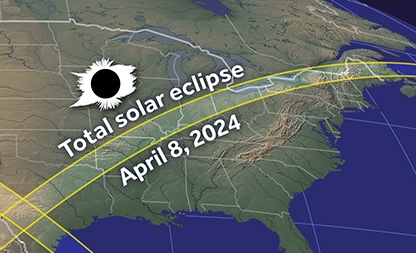1 PADUCAH, Ky. — Kentucky state and local agencies are continuing to plan for traffic surges expected during and after the total solar eclipse that will sweep across 13 states one month from now — the afternoon of Monday, April 8, 2024. In addition to asking travelers to be prepared, all businesses in the eclipse travel corridor are encouraged to make plans to maintain their supply lines and inventory of high-demand items ahead of the event.
PADUCAH, Ky. — Kentucky state and local agencies are continuing to plan for traffic surges expected during and after the total solar eclipse that will sweep across 13 states one month from now — the afternoon of Monday, April 8, 2024. In addition to asking travelers to be prepared, all businesses in the eclipse travel corridor are encouraged to make plans to maintain their supply lines and inventory of high-demand items ahead of the event.
The celestial event is expected to bring at least 150,000 visitors to the path where it crosses several Western Kentucky counties, with more than 1 million travelers predicted to drive through Kentucky to nearby viewing spots along the main path in Ohio, Indiana and Illinois.
Heavier than normal traffic could occur the weekend before the eclipse, especially near viewing areas in Hickman, Carlisle, Ballard, McCracken, Livingston, Crittenden, Union and Henderson counties. The most significant traffic rush is expected after the eclipse ends there and along Kentucky’s north-south highways as eclipse watchers head home.
Based on Kentucky’s 2017 total solar eclipse experiences, the Kentucky Transportation Cabinet (KYTC) is working with Kentucky Emergency Management (KYEM), Kentucky State Police (KSP) and local emergency agencies on potential event impacts, including the potential traffic issues that may arise from thousands of visitors traveling through the commonwealth.
“We are encouraging area businesses across Kentucky to plan ahead for the influx of visitors,” said KYEM Interim Director Dustin Heiser. “While Kentucky is not the epicenter for eclipse chasers as it was in 2017, the potential for shortages of fuel, water, food and other staples will exist. We encourage residents and businesses to make eclipse plans with that in mind.”
KYTC Secretary Jim Gray shared practical tips for travelers to prepare for traffic surges.
“Spectators are encouraged to come early and stick around after the event to reduce the potential for hours-long gridlock that’s possible when a wave of thousands of drivers return home after the event,” said Secretary Gray. “Similar to a severe snow event, motorists should travel with an emergency car kit stocked with essential items for all passengers. It’s also a good idea to bring printed directions to your destination if there are cell service disruptions that impact your navigational apps.”
Some local business owners, including convenience stores and truck stops along the solar eclipse travel corridor, have reported they will follow the same practices a week ahead of other high-traffic events like the Bonnaroo Festival and Fan Fair in Nashville by stocking extra staple items, such as bottled water, keeping fuel storage tanks topped off and scheduling extra fuel deliveries at night when traffic is light.
Business Tips for a Safe Event
State officials offered the following suggestions for businesses:
- Plan early and overnight delivery of critical supplies due to possible daytime traffic snarls.
- Increase inventory of essential items with temporary storage space prior to the eclipse.
- Have delivery trucks and employees allow extra travel time for congestion.
- Plan fuel and food deliveries at night to avoid traffic.
- Consider flex work schedules to avoid expected difficult travel conditions.
- Encourage employees to have a full tank of gas prior to the time visitors begin to arrive in the area.
Spectator Tips for a Safe Event Transportation officials offer the following suggestions for event goers:
- Plan ahead. Pick a viewing destination and book accommodations in advance. Get eclipse-viewing glasses.
- Be prepared. Travel with enough food and water for everyone in your vehicle. Expect lines at restaurants, convenience stores and grocery stores. Check the local weather.
- Drive smart. Don’t stop along highways or take photos while driving. Watch for pedestrians. Fill up or charge up your vehicle before traveling. Turn on headlights.
- Come early, stay late. Avoid leaving immediately after the event to reduce traffic congestion. Visit Kentucky attractions while in town. Several local communities in the total viewing path are organizing eclipse-related events on April 8.
Forecasted Traffic Impacts Traffic into and through Western Kentucky along Interstate 24, Interstate 69 and U.S. 41 is expected to be congested, as is traffic along the Pennyrile Parkway before, during and after the eclipse. The eclipse will add traffic to U.S. 231 and I-165, as well as I-64, I-65, I-71, I-75 and other north-south corridors that parallel these routes. Immediately after the eclipse, there is particular concern about traffic delays at Kentucky’s Ohio River crossings, where traffic from the main eclipse path to the north will enter Kentucky. Transportation Cabinet staff are evaluating options to temporarily remove lane restrictions in active work zones on select routes ahead of the event to ease traffic congestion. More details will be shared once plans are finalized.
The total solar eclipse will impact eight Kentucky counties and clip portions of four others. The totality phase will enter Kentucky around 2 p.m., CDT, April 8, in parts of Fulton and Hickman counties before crossing Ballard, McCracken, Livingston, Crittenden, Union and Henderson counties along the Ohio River. It will also pass over small portions of Carlisle, Graves, Webster and Daviess counties.
Follow KYTC statewide and district social media pages for eclipse-related traffic and travel information in Kentucky at transportation.ky.gov/DistrictPages. Real-time traffic information is also available online at GoKY.ky.gov or on the Waze app.
Additional eclipse planning resources are available at the following sites:


















